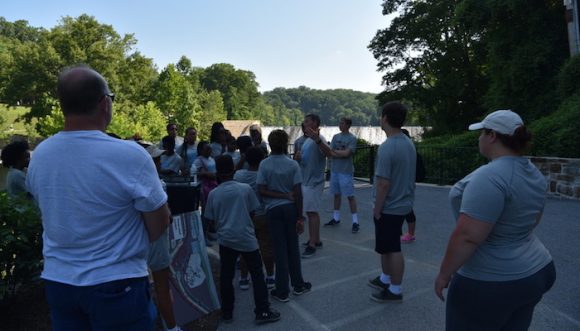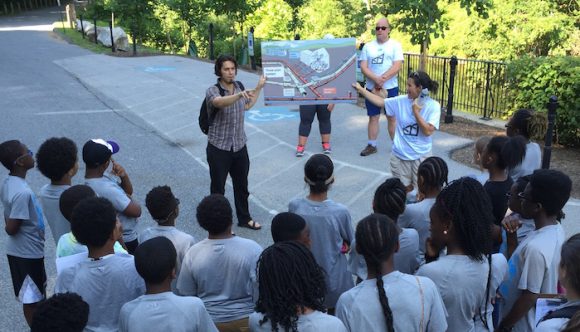Watershed Tour of Jones Falls
Blue Water Baltimore’s Outreach & Education Coordinator, Michel Anderson, accompanied students on a local watershed tour of the Jones Falls. Read about the experience from the perspective of one of the Bridges at Gilman School program leaders, Ned Harris, and one of his students.
The Tour
On the morning of Thursday, July 21, 2016 more than 30 rising sixth graders from Bridges Baltimore gathered at the south end of the St. Paul’s School campus in the Greenspring Valley to trace the course of the Jones Falls from near its headwaters to its mouth at Baltimore’s Inner Harbor.
 The purpose of our field trip was threefold, to:
The purpose of our field trip was threefold, to:
- Educate students about the history of water use in the Baltimore region
- Introduce students to the various ways that urban streams can become degraded
- Show them how they might contribute to the preservation of clean water in their city
We made several stops on our way to the harbor – at the Lake Roland dam, at Meadow Mill where the Falls runs under the Jones Falls Expressway, near the intersection of Falls Rd. and Howard St. where the Falls is funneled into underground pipes, and at the corners of Fallsway, East Biddle St. and Guilford St. where a monument to the burial of the Jones Falls stands. It was exciting to see how the waterway grows in size from a tiny trickle in Baltimore County to a deep and wide stream when it empties in the harbor just south of Eastern Avenue.

Student Reflections
Students had loads of questions for Michel Anderson, our leader, and one student, Curtis Lawson, wrote a reflection about his experience on the trip. His account follows:
On my Blue Water Baltimore trip, I learned a lot about the water that comes into our houses. One thing I learned is that Baltimore’s water used to come from one normal-sized reservoir, but because of the increase to the population and contamination of our water we changed to two huge reservoirs. Lake Roland was originally the reservoir that our drinking water came from, but due to the use of a (now) illegal pesticide found in the water, everyone eventually stopped drinking from it. I also learned that Blue Water Baltimore is set on cleaning the water in our city. The organization’s goal is to help completely clean the Inner Harbor within the next ten to fifteen years. They are doing this by planting trees on eroding riverbanks and using engineering techniques to hold the soil in place. I think it would be great to be able to swim in the harbor someday. In my opinion, this was the best field trip of the summer, and I hope the next group of rising sixth graders will experience it too!
Interested in Getting Your Students Involved?
Contact Michel Anderson [email protected] for more information about arranging an experiential educational experience on one of our local waterways.

